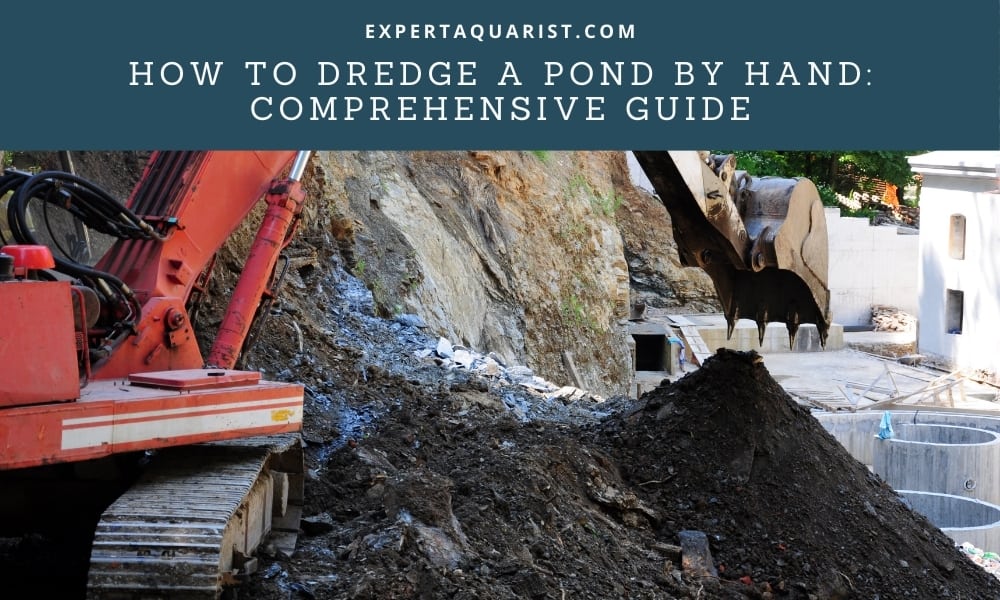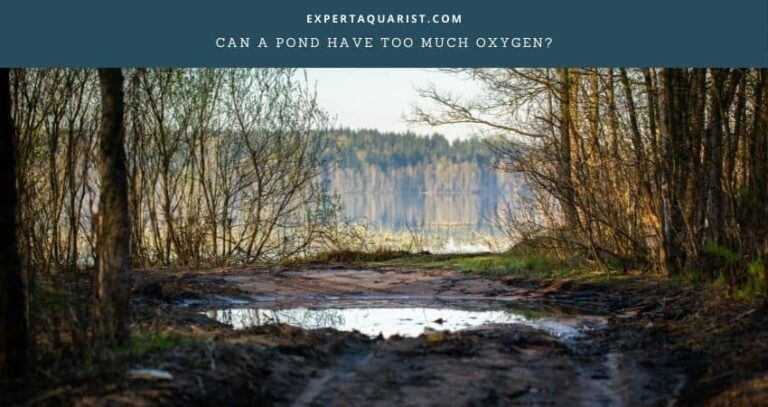For the sake of your fish and the surrounding environment, you must always keep your pond clean. An invisible enemy of your pond is debris.
People neglect it and let it accumulate until one day it becomes a headache for you. At that time, it’ll block sunlight, promote weed and algal growth, and suffocate your fish. In short- it’ll cause chaos in your pond.
The best way to avoid such a situation is to dredge the pond. Learning how to dredge a pond by hand is easy – empty your pond and scoop up all the muck with your hands, shovel, and a bucket.
But you’ll have difficulty with large ponds without machinery.
Learn everything about dredging by scrolling down. I got juicy stuff…
How to Dredge a Pond Alone: DIY Dredging Methods
You could either do the dredging process using big fancy machines, or you could do it by yourself. If all you need to dredge is a backyard pond, you don’t need any major effort.

Let me describe a how you could DIY a pond dredging activity:
1. Dredging by bare hands
Here we are gonna take the “dredging the pond by hand” thing a bit too seriously. That’s right; we’re gonna start by showing you how to dredge by literally using your hands for it.
I love people who are not afraid to get their hands dirty to get what they need.
So, at the very beginning, you should take out all the fish and stock them in a fish tank just for safekeeping. Later on, you will have to suck up all the water from the pond. Now there’s only you and a dry pond.
Head down inside the pond where once water was present; fishes used to roam.
Use a rake and remove the vegetation slowly. Make sure to cover the whole pond; sitting in the center is an excellent way to cover most areas easily.
Now, little by little, scoop up all the debris, sludge, algae, semi-solids, etc. whatever you find and take them out.
This is a bit tedious and might take you long. You could use a shovel and a bucket to speed up this process. Actually, having a shovel is quite useful because you might face some difficulty removing fully solid materials.
Using hands to dredge a pond might be a bit tedious, but hey, isn’t it simple?
But, there’s a limit of how much you can achieve with this. I’ll just be honest with you- using machinery will yield higher results.
Besides, if you have a large pond, you would most likely be famished and exhausted before you even finish.
In case you change your mind, I’m going to briefly describe methods that need machinery for dredging a pond as well:
Pond Dredging Using Machines
1. Mechanical dredging
This is an expensive and vintage method where you use excavators to scoop up debris and other materials that cause nuisance from your large pond. You’ll have to drain your pond and move your fish for this method.
2. Hydro-raking
For dealing with aquatic vegetation and organic material, this is the best method. You use a backhoe that is mounted on a rake to pull out these troublesome mucks that are settled up to 18 inches deep.
3. Sediment removal solution
Here we use suction pumps to suck out the muck and waste. Compared to orthodox dredging, this is safer. You can use the pump to send these sediments somewhere far or trap them in a container.
4. Organic sediment removal system
This is albeit similar to the previous method, but here alongside the debris, the pump also pulls up harmful gases and toxins, as well as foul odors. You’ll be left with a clean bottom soil. I found it to be extremely efficient.
5. Suction dredging
Here, you’d need help from a diver, unless you’re the one going in. The diver will pump the sediments mixed with water away to a field or a landscape. If you don’t want to pump, you can fill it in a bag and manually carry it away.
This process is best for silt plagued ponds. After throwing away the solids you can return the water after it passes through a filter.
6. Hydraulic dredging
In this method, you’d be using a vacuum cleaner that will pull up everything from the bottom of the pond. The solids get pumped away, the dry material is trapped in a geo bag, and the water is sent for either drainage or filtering.
In case you need high tech stuff but can’t allow heavy equipment, this is the right approach.
Benefits of Dredging a Pond
Of course, you aren’t a mad person that you’ll take out all the water in your pond, relocate your fish and start scrubbing at the bottom of your pond for kicks!
There are some reasons that make dredging beneficial, and that’s why many of us do it. Here is a summary of them:
1. Keeps your pond clean
Since dredging involves throwing away debris out of your pond, it’s a cleaning process of sorts. By doing this, you can avoid murky pond water. Everyone wants crystal clear water in their pond, right?
So, by dredging regularly, you get to keep your pond from turning into a swamp.
2. Makes a rich topsoil
When you’ll be dredging, you’ll find a lot of organic matter scattered all over the place. If you wanna do things smartly, then you should use them as topsoil for your pond. They’ll be great for your plants.
You could also take them for your garden and use them as fertilizers, and because they are so rich in nutrients, they actually do a great job at that.
3. Maintains a healthy ecosystem
Dredging helps beneficial bacteria to proliferate, and that increase will lower the amount of waste in the pond, so the fish and plants will have an easier life inside your pond.
Your fish and plants get to live a healthy and peaceful life, that’s always the goal, isn’t it?
4. Raises property value
The 3 points above clearly indicate one thing- that dredging keeps your pond well maintained. And a well-maintained pond is not only bewitching but improves the value of your property.
According to the University of Maine, you could earn up to $200 per foot just by having a well-maintained and beautiful pond in your backyard.
If you’re ever planning to sell your property, you know what to do.
5. Reduces maintenance needs
Let’s see; dredging improves the water quality, gets rid of debris, and helps break down waste. Isn’t that something you want from your maintenance rounds?
I believe dredging itself is a kind of maintenance for the pond.
6. Stops eutrophication
While nutrients are suitable for a pond, excess phosphorus and nitrogen are never a welcomed sight. Having an excess of these is a bust for your pond.
Why so? Because having more nutrients than necessary will invite algae to bloom in your pond.
7. Avoids clogging of machines
The structures and machines in your pond [like pumps or filters] can get jammed due to excess sediments present in the pond. These are essential components of your pond, as important as limbs are for us.
So, by regularly getting rid of them, we let our devices work as intended.
8. Suppresses weed growth
If you keep dredging regularly, you’ll have a pond that you can be proud of, guaranteed!
When should I dredge my pond?
Actually, you should always be looking to dredge your pond; at least twice a year is the bare minimum.
If you can’t dredge regularly, then you must keep your eyes open for signs.
If you see any of the following indications, then you should get serious:
1. Water shrinkage
Be it summer, fall, or winter; you can expect debris to make its way into your pond in various ways. In a calendar year, you’ll definitely end up with a massive pile of debris and junk.
As they pile up in the center, it’ll gradually start shrinking the pond. If you have a medium-sized pond, you won’t notice it straight away, so you should observe it.
The sudden shrink of the pond is an easy indicator.
2. Algal bloom
As I mentioned before, piled-up debris makes way for an algae outbreak. The debris turns into sludge that generates excessive nutrients for the pond.
Thus algae start their aggressive growth. And when you don’t keep them in check, the algal bloom makes the pond toxic for fish and plants, as well as make the pond muddy.
As soon as you see a greenish hue in your pond, that’s your cue.
3. Sudden increase of plants
Nature has its ways of hinting that things are not okay. Sometimes these are quite subtle, just like this one. If you notice wildlife that generally surrounds the pond [for example- birds] and plants are rapidly increasing, there’s the hint.
Although the number of plants is rising, it’s not a happy thing, because most of these are weeds or a detrimental kind like cattails.
You should kill the weeds without mercy. As for cattails, you have to not only kill them but also make sure they can’t reemerge, as they’re highly potent.
4. Muddy water
If you see mud get easily visible just by doing trivial things like entering/exiting a pond, that’s a sign that there is excess mud in the pond. You should clean the muddy pond water without haste.
The inability to be clean quickly after heavy rainfall is also a warning for you.
5. Bad water quality
Let’s rewind a bit and look at all the trouble we get from sedimentation and the piles of debris. We can easily see that things like lots of algae, muddy water, clogging, eutrophication, etc., actively affect the water quality of your pond.
A smart pond owner regularly checks out their pond’s water quality, so if you see any anomalies, you should start cleaning up.
6. Odor
The debris that accumulates in your pond will eventually turn into organic matter. And when the organic matter starts to decompose and gradually hit a critical range, the byproducts they release will emit a foul smell onto the pond.
You could say this is a pond’s cry for help. If you happen to see this, then the waste build-up is excessive, and you have to act as soon as possible.
Disadvantages of dredging
Dredging can save you from a lot of trouble, but this process itself has a downside or two. Since you’re directly removing life from the pond, you could ruin the ecology.
Also, another matter is that people don’t know when to stop and go overboard. For example, by dredging, you tone down the excess nutrients present in the pond, but you’ll be left with nutrient efficiency if you go overboard.
On the other hand, if you undergo dredging without a clear plan, chances are you’ll end up releasing more nutrients and risk eutrophication.
To avoid such scenarios, it’d be a good idea to install some filters and aerators.
Cost of Dredging A Pond
How much you’d have to spend depends on the following factors:
- Nature of the debris
- Amount
- Size of your pond
- How you want to get rid of them
To get the right idea, you need to do a thorough survey. As a silt dominated pond will be different from a pond that’s engulfed with organic matter; you need other ways to treat them.
I’ll suggest going for the DIY way if the pond is small. Alternatively, hydro-raking is also a good idea.
But for large ponds, DIY is too inefficient and slow. You should go for any of the sediment removal processes or hydraulic dredging.
As for the medium ones, you can try any of them except the DIY method.
Let’s keep our ponds clean!
I originally planned to show you how to dredge a pond by hand only but ended up making a comprehensive pond dredging guide. I felt providing only what you wanted wasn’t enough, and you need to know the rest of the job too, or at least have a basic idea.
Well, I did my part. Now, nothing about pond dredging should come as a surprise to you. I’m confident this article will help you become a better pond owner.






